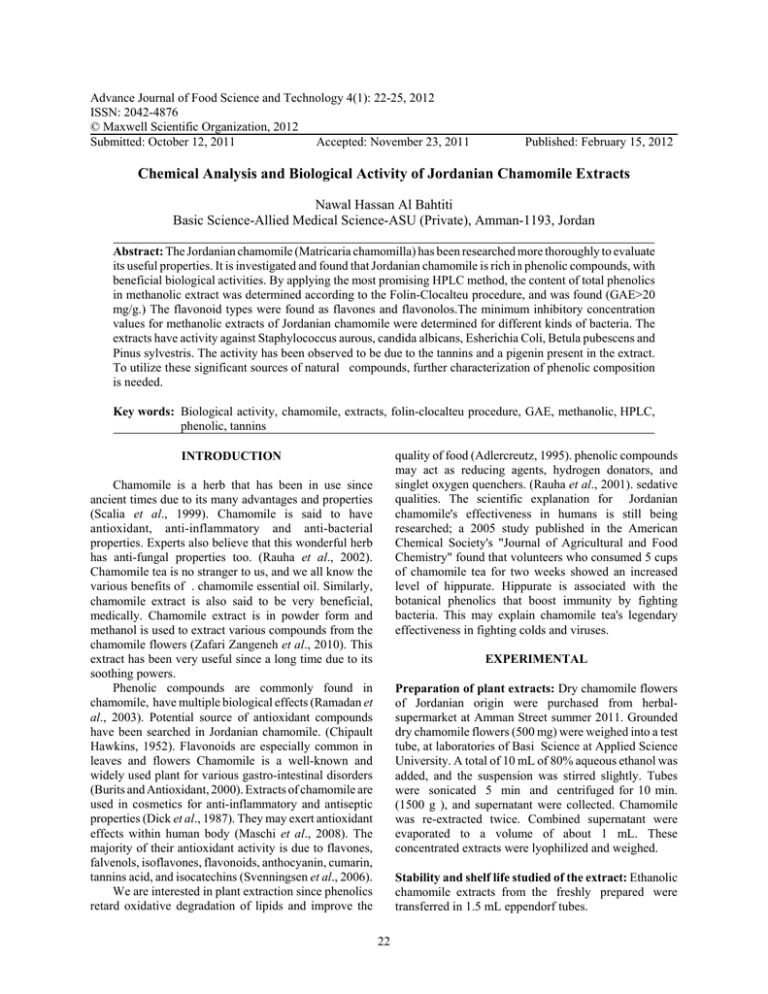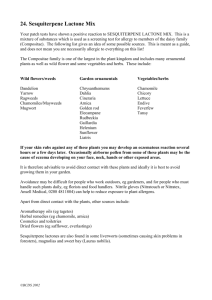Advance Journal of Food Science and Technology 4(1): 22-25, 2012
advertisement

Advance Journal of Food Science and Technology 4(1): 22-25, 2012 ISSN: 2042-4876 © Maxwell Scientific Organization, 2012 Submitted: October 12, 2011 Accepted: November 23, 2011 Published: February 15, 2012 Chemical Analysis and Biological Activity of Jordanian Chamomile Extracts Nawal Hassan Al Bahtiti Basic Science-Allied Medical Science-ASU (Private), Amman-1193, Jordan Abstract: The Jordanian chamomile (Matricaria chamomilla) has been researched more thoroughly to evaluate its useful properties. It is investigated and found that Jordanian chamomile is rich in phenolic compounds, with beneficial biological activities. By applying the most promising HPLC method, the content of total phenolics in methanolic extract was determined according to the Folin-Clocalteu procedure, and was found (GAE>20 mg/g.) The flavonoid types were found as flavones and flavonolos.The minimum inhibitory concentration values for methanolic extracts of Jordanian chamomile were determined for different kinds of bacteria. The extracts have activity against Staphylococcus aurous, candida albicans, Esherichia Coli, Betula pubescens and Pinus sylvestris. The activity has been observed to be due to the tannins and a pigenin present in the extract. To utilize these significant sources of natural compounds, further characterization of phenolic composition is needed. Key words: Biological activity, chamomile, extracts, folin-clocalteu procedure, GAE, methanolic, HPLC, phenolic, tannins quality of food (Adlercreutz, 1995). phenolic compounds may act as reducing agents, hydrogen donators, and singlet oxygen quenchers. (Rauha et al., 2001). sedative qualities. The scientific explanation for Jordanian chamomile's effectiveness in humans is still being researched; a 2005 study published in the American Chemical Society's "Journal of Agricultural and Food Chemistry" found that volunteers who consumed 5 cups of chamomile tea for two weeks showed an increased level of hippurate. Hippurate is associated with the botanical phenolics that boost immunity by fighting bacteria. This may explain chamomile tea's legendary effectiveness in fighting colds and viruses. INTRODUCTION Chamomile is a herb that has been in use since ancient times due to its many advantages and properties (Scalia et al., 1999). Chamomile is said to have antioxidant, anti-inflammatory and anti-bacterial properties. Experts also believe that this wonderful herb has anti-fungal properties too. (Rauha et al., 2002). Chamomile tea is no stranger to us, and we all know the various benefits of . chamomile essential oil. Similarly, chamomile extract is also said to be very beneficial, medically. Chamomile extract is in powder form and methanol is used to extract various compounds from the chamomile flowers (Zafari Zangeneh et al., 2010). This extract has been very useful since a long time due to its soothing powers. Phenolic compounds are commonly found in chamomile, have multiple biological effects (Ramadan et al., 2003). Potential source of antioxidant compounds have been searched in Jordanian chamomile. (Chipault Hawkins, 1952). Flavonoids are especially common in leaves and flowers Chamomile is a well-known and widely used plant for various gastro-intestinal disorders (Burits and Antioxidant, 2000). Extracts of chamomile are used in cosmetics for anti-inflammatory and antiseptic properties (Dick et al., 1987). They may exert antioxidant effects within human body (Maschi et al., 2008). The majority of their antioxidant activity is due to flavones, falvenols, isoflavones, flavonoids, anthocyanin, cumarin, tannins acid, and isocatechins (Svenningsen et al., 2006). We are interested in plant extraction since phenolics retard oxidative degradation of lipids and improve the EXPERIMENTAL Preparation of plant extracts: Dry chamomile flowers of Jordanian origin were purchased from herbalsupermarket at Amman Street summer 2011. Grounded dry chamomile flowers (500 mg) were weighed into a test tube, at laboratories of Basi Science at Applied Science University. A total of 10 mL of 80% aqueous ethanol was added, and the suspension was stirred slightly. Tubes were sonicated 5 min and centrifuged for 10 min. (1500 g ), and supernatant were collected. Chamomile was re-extracted twice. Combined supernatant were evaporated to a volume of about 1 mL. These concentrated extracts were lyophilized and weighed. Stability and shelf life studied of the extract: Ethanolic chamomile extracts from the freshly prepared were transferred in 1.5 mL eppendorf tubes. 22 Adv. J. Sci. Technol., 4(1): 22-25, 2012 a) flavonoids b) tannins c) Phenolic acids Fig. 1: Typical structures of some groups of plant phenolic These tubes were distributed in 3 groups t store at -20ºC, 4ºC and at room temperature. The tubes were retracted at 15, 30, 60, 90 and 120 days for analysis and dissociation of glucoside bond and. In addition, we performed stability studies on ethanolic chamomile extracts at different pH, light exposure and long term storage. 23 Adv. J. Sci. Technol., 4(1): 22-25, 2012 Table 1: Composition of jordanian chamomile extract (mg/g of dried extract) Compounds Concentration mg/g Retentions time (min) Quercitrin 23.7 6.5 Myricitrin 7.9 16.5 Kaempferitrin 10.1 18.5 Table 2: Minimum Inhibitory Concentration (MIC) of chamomile extract against different microorganism Microorganism MIC of extract :g/mL Staphylococcus 32.5 Candida albicans 65 Escherichia Coli 250 Betula pubescens 125 Pinus sylvestris 500 Myricitrin Determination of total phenolics: The amount of total phenolics in extracts was determined according to folinClocalteu procedure (10). The total phenolic content was expressed as Gallic Acid Equivalents (GAE) in mg/g dry material. HPLC analysis: A 10 :L of methanolic solution was injected into HPLC system (GRD-10-0062) with a UVvisible detector. A Cap cell Pack UG 120C 18 columns was used. The mobile phase consisted of 80% methanol. The gradient was 20% in 60 min at a flow rate 0.20 mL/min. Quercitrin Kaempferitrin Minimum Inhibitory Concentration (MIC) test: The samples were tested for their antimicrobial testing in vitro by the agar dilution technique. All samples were dissolved in Dimethyl Sulphoxide Solvent (DMSO) for the antimicrobial test and the solutions were sterilized by membrane filtration. Aliquots of samples were diluted with melted typtic Soy agar,tryptone,soytone,sodiuam chloride and agar to give concentrations of 2000, 1500, 1000, 500, 250, 125, 62.5 and 31.3 :g/mL. The MIC value were noted after 24 h at 37ºC as shown in Table 2. Fig. 2: Structure of isolated compounds mAU 750 1 2 500 3 250 5 RESULTS AND DISCUSSION 10 15 20 min Fig. 3: HPLC-UV profile of methanol extract, detection at 280 nm.1: Kaempferitrin; 2: Quercitrin; 3: Myricitrin The amount of dry weight of extract was 17mg, while the amount of total phenolics in chamomile extract was 23.2 mg/g.dry chamomile15 UV-vis Absorption at 280530 nm were measured (PerkinElmer# spectrophotometer Norwalk, CT), p-hydroxybenzoic acid can be detected at 260nm,catechins at 280nm,and anthocyanins at 530nm (Fig. 3).The conjugated C-C double bonds which act as chromophores made (UV/Vis) detector can be used in both qualitative and quantitative analysis of naturederived samples containing phenolics (Fig. 1 and Table 1). Identified compounds in extract were: Kaempferitrin (at 320 nm), Quercitrin, Myricitrin (at 280 nm). Figure 2, but no identified substances as Anthocyanins .The phenolic compounds of natural origin have the positive property of being soluble in polar solvents, this leads to the possibility of using reversed phase HPLC, stationary phase was octadecylsilane (ODS, C18, RP-18), The eluent was methanol and (UV/Vis) detector (Fig. 3). These glucosides are highly stable in solution at different temperature range and their degradation occurs after long-term storage and extraction conditions at different pH and solvent. The extract was tested for its antimicrobial testing in vitro by the agar dilution technique (Adlercreutz, 1995) the extract of chamomile has activity against Staphylococcus and Candida albicans, and noticeable activity against other microorganisms (Table 2). 24 Adv. J. Sci. Technol., 4(1): 22-25, 2012 Chipault, J.R. and J.M. Hawkins, 1952. The antioxidant properties of natural spices. Food Res., 17: 46-55. Dick, A.J., P.R. Redden, A.C. De Marco, P.D. Lidster and T.B. Grindley, 1987. Flavonoid glycosides of Spartan apple peel. J. Agric. Food Chem., 35(4): 529-531. Maschi, O., E.D. Cero, G.V. Galli, D. Caruso, E. Bosisio and M. Dell'Agli, 2008. The spasmolytic effect of Matricaria recutita L. J. Agric. Food Chem., 56(13): 5015-5020. Ramadan., M.F., L.W. Kroh and J.T. Morsel, 2003. Radical scavenger activity of black cumin. J. Agric. Food Chem., 51: 6961-6969. Rauha, J.P., J.L. Wolfender, J.P. Salminen, K. Pihlaja, K. Hostettmann and H. Vuorela, 2001. Characterization of the polyphenolic composition of purple loosestrife (Lythrum salicaria). Zeitschrift für Naturforschung, 56(1-2): 13-20. Rauha, J.P., S. Remes, M. Hieonen and P. Vuorela, 2002. Antimicrobial effects of finnish plant extracts containing flavonoids and other phenolic compounds. Int. J. Food Microbiol. 56(1): 3-12. Scalia, S., L. Giuffreda and P. Pallado 1999. Analytical and preparative supercritical fluid extraction of chamomile flowers and its composition with conventional methods. J. Pharm. Biomed. Anal., 21(3): 549-558. Svenningsen, A.B., K.D. Madsen, T. Liljefors, G.I. Stafford, J. Van Staden and A.K. Jäger, 2006. Biflavones from Rhus species with affinity for the GABA (A) benzodiazepine receptor .J. Ethnopharmacol., 103(2): 276-280. Zafari Zangeneh, F., B. Minaie, A. Amirzargar, A. Ahangarpour and K. Mousavizadeh, 2010. Effects of chamomile extract on biochemical and clinical parameters in a rat model of polycystic ovary syndrome. J. Reprod. Infertil., 11(3): 169-175. CONCLUSION Three different compounds were isolated and identified by HPLC technique as flavone and flavonol, Compoundsare; kaempferol-o-glucosides, quercetin-oglycosides, and myricetin-o-glycosides, but no identified compound as anthocyanins. The chamomile extract showed antimicrobial activity in this study, Jordan provides an interesting source of plants for studying their chemical composition and its effects in biological systems and man. Several serviceable in vitro tests that illuminate the property of interest are available for screening plants and their constituents in order to find the most effective materials and components for further investigations. ACKNOWLEDGMENT The author acknowledges Mr. Mazin Gannam at Pharma International company for HPLC analysis.The author acknowledges Applied Science Private University, Amman, Jordan, for the financial support granted to cover the publication fee of this research article. Sincere thanks to all my colleagues at basic science-chemistry department, for creating inspiring conditions for work. REFERENCES Adlercreutz, H., 1995. Phytoestrogens: Epidemiology and a possible role in cancer protection. Environ. Health Perspect, 103(7): 103-112. Burits M.B. and F. Antioxidant, 2000. Activity of Nigella sativa essential oil. Phytother. Res., 14: 323-328. 25



